
COMPUTATIONAL COMPLEXITY
Scope & Guideline
Pioneering Insights into Mathematical Algorithms
Introduction
Aims and Scopes
- Theoretical Foundations of Complexity Classes:
This area explores the foundational aspects of complexity classes such as P, NP, NP-complete, and beyond. It includes studies on the relationships between these classes, as well as their implications for algorithm design and computational limits. - Approximation Algorithms and Hardness:
Research focusing on approximation algorithms investigates the feasibility of finding near-optimal solutions for NP-hard problems. This includes establishing hardness results and developing efficient approximation techniques. - Algebraic Complexity Theory:
This scope examines the complexity of problems from an algebraic perspective, including the study of algebraic branching programs, circuits, and polynomials. This area is crucial for understanding the computational power of algebraic systems. - Communication Complexity:
This area addresses the resources required for communication between computational entities and is essential for understanding distributed computing models. Studies often involve analyzing protocols and their efficiency. - Graph Theory and Combinatorial Structures:
Research in this domain focuses on the complexity of problems related to graph theory, including coloring, matching, and structural properties of graphs. These studies often have implications for both theoretical computer science and practical applications. - Quantum and Randomized Complexity:
This area explores the differences between classical and quantum computation, as well as the role of randomness in algorithms. Research often investigates how these models can solve problems more efficiently than classical approaches.
Trending and Emerging
- Algorithmic Lower Bounds and Complexity Gaps:
There is a growing interest in establishing lower bounds for various computational models, especially in relation to algebraic circuits and branching programs. This trend reflects a deeper inquiry into the limitations of current algorithms and computational frameworks. - Streaming Algorithms and Online Complexity:
Recent studies have increasingly focused on streaming algorithms, which are designed to process data in a single pass. This theme is relevant due to the rise of big data and the need for efficient algorithms that can handle large-scale inputs. - Interplay Between Complexity and Algebra:
There is an emerging focus on the connections between algebraic structures and computational complexity, particularly regarding polynomial identities and algebraic branching programs. This indicates a trend towards exploring foundational mathematical concepts in relation to complexity. - Quantum Complexity and Communication Models:
Research on quantum complexity, especially in conjunction with communication models, has gained prominence. This reflects the growing importance of quantum computing and its implications for traditional complexity theory. - Complexity of Approximation Problems:
An increasing number of papers are dedicated to the complexity of approximation problems, indicating a trend towards understanding how to efficiently approximate solutions to complex computational problems.
Declining or Waning
- Classical Circuit Complexity:
There has been a noticeable decline in papers focusing solely on classical circuit complexity, particularly those that do not integrate newer approaches or connections to other areas of complexity theory. - Basic Complexity Theory without Applications:
There seems to be a waning interest in foundational studies of complexity theory that do not link to practical applications or other domains, suggesting researchers are increasingly looking for interdisciplinary connections. - Deterministic Algorithms for Hard Problems:
The focus on deterministic algorithms for traditionally hard problems appears to be diminishing, as more researchers are exploring randomized and approximation strategies that yield practical results. - Basic Graph Algorithms:
Research centered on basic graph algorithms without deeper complexity implications has seen reduced attention, likely due to the increasing complexity of problems being considered in conjunction with graph theory.
Similar Journals

Bulletin of the European Association for Theoretical Computer Science
Fostering Innovation in Theoretical Computer Science ResearchBulletin of the European Association for Theoretical Computer Science is a distinguished journal dedicated to the field of theoretical computer science, published by the European Association for Theoretical Computer Science. With its focus on theoretical underpinnings, algorithmic framework, and the advancement of computational theories, this journal serves as a crucial platform for researchers, professionals, and students alike. While not an open access journal, it offers vital insights and findings that significantly contribute to the academic community in theoretical computer science. The journal is headquartered in Greece, at the Computer Technology Institute and Press-CTI in Rio, symbolizing a rich tradition of scholarly exchange within the European context. Researchers aiming to disseminate their work in this niche yet impactful area will find the Bulletin's blend of rigor and relevance invaluable as they seek to push the boundaries of knowledge in computational theory.
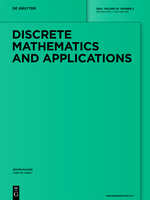
Discrete Mathematics and Applications
Unlocking the Potential of Discrete Mathematics for Real-World Impact.Discrete Mathematics and Applications, published by WALTER DE GRUYTER GMBH, is a vital academic journal catering to the expansive fields of Discrete Mathematics and Applied Mathematics. With an ISSN of 0924-9265 and an E-ISSN of 1569-3929, it serves as a reputable platform for disseminating innovative research and developments within these domains. The journal has been contributing to the academic landscape since its inception in 1991 and continues to actively publish impactful studies through 2024. Despite its current positioning in Q4 of both the Applied Mathematics and Discrete Mathematics and Combinatorics categories, the journal is dedicated to fostering essential discussions that advance understanding and application of discrete mathematical concepts. It provides researchers, professionals, and students with access to a wealth of knowledge, encouraging collaboration and growth within the field. With its strategic German headquarters in Berlin and a focused aim to enhance the visibility and significance of discrete mathematics in real-world applications, Discrete Mathematics and Applications stands out as an important resource for those seeking to contribute to the ongoing evolution of mathematical sciences.
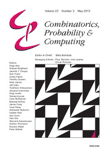
COMBINATORICS PROBABILITY & COMPUTING
Bridging Theory and Practice in Combinatorial ResearchCOMBINATORICS PROBABILITY & COMPUTING is a premier journal published by Cambridge University Press, focusing on the cutting-edge fields of combinatorics, probability, and their computational aspects. Established in 1992 and set to continue its impactful discourse through 2024, this journal holds a distinguished reputation, reflected in its Q1 ranking in applied mathematics, computational theory, and statistics, showcasing its pivotal role in advancing research in these areas. With an ISSN of 0963-5483 and an E-ISSN of 1469-2163, the journal welcomes high-quality papers that contribute to the theoretical foundations and practical applications of the disciplines. While it is not available as open access, its accessibility through institutional subscriptions ensures wide readership within academia. The journal is a vital resource for researchers, professionals, and students alike, providing a platform for innovative ideas and pioneering research that shapes the future of mathematics and computer science.
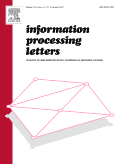
INFORMATION PROCESSING LETTERS
Transforming Ideas into Information SolutionsINFORMATION PROCESSING LETTERS, published by ELSEVIER and with an ISSN of 0020-0190, is a prominent academic journal that serves as a vital resource in the fields of Computer Science, Information Systems, and Signal Processing, among others. As evidenced by its Q3 ranking across various categories in 2023, including Computer Science Applications and Theoretical Computer Science, it provides a rigorous platform for the dissemination of innovative research and theoretical developments. Researchers and professionals can delve into a wide array of subjects pertinent to information processing, contributing to advancements in technology and data management. Although it does not offer Open Access options, the journal maintains an influential presence in scholarly discourse, making it a crucial reference for those engaged in computational innovations and system optimizations. With coverage from 1971 to 2025, it continues to be integral for both seasoned academics and emerging scholars.

International Journal of Computer Mathematics- Computer Systems Theory
Innovating Theories in Computer Systems and MathematicsInternational Journal of Computer Mathematics - Computer Systems Theory, published by Taylor & Francis Ltd, is a vital resource in the fields of computational mathematics and computer systems theory. With an ISSN of 2379-9927 and E-ISSN 2379-9935, this journal has established a prominent presence in academia since its inception in 2016. It is categorized in the Q3 quartile for both Computational Mathematics and Computational Theory in 2023, reflecting its impact and contribution to the scholarly discourse within these domains. The journal’s Scopus rankings further emphasize its academic relevance, placing it in the 38th and 33rd percentiles in their respective categories. International Journal of Computer Mathematics aims to disseminate innovative research findings, methodologies, and theoretical advancements, making it an essential publication for researchers, professionals, and students looking to deepen their understanding of computational methods and applications. Although it currently does not offer open access, the journal continues to provide insightful contributions to the scientific community, fostering the evolution of computational sciences.
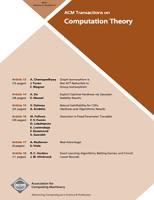
ACM Transactions on Computation Theory
Fostering Collaboration in Cutting-edge Computational Research.ACM Transactions on Computation Theory, published by the Association for Computing Machinery, is a prestigious journal dedicated to advancing the field of computation theory and theoretical computer science. With an ISSN of 1942-3454 and an E-ISSN of 1942-3462, this journal serves as a vital resource for researchers and professionals seeking to explore groundbreaking developments in computational models, algorithms, and their mathematical foundations. The journal's rigorous standards have earned it a significant position within the academic community, as evidenced by its 2023 category quartiles, ranking in the Q1 category for Computational Theory and Mathematics and Q2 for Theoretical Computer Science. Although it operates through traditional subscription access, it maintains a critical role in disseminating cutting-edge research and fostering collaboration among experts in the United States and beyond. As an influential platform, ACM Transactions on Computation Theory is committed to contributing to the ongoing dialogue and advancement of computation theory, making it essential reading for anyone passionate about this dynamic field.

Algorithms
Pioneering Open Access to Algorithmic Knowledge.Algorithms is a prestigious and innovative journal published by MDPI, focusing on the rapidly evolving fields of computational mathematics, numerical analysis, and theoretical computer science. Launched in 2008, this open access journal seeks to foster collaboration and knowledge sharing among researchers, professionals, and students by providing a platform for the dissemination of high-quality research articles, reviews, and notes. With its operational base in Basel, Switzerland, Algorithms has steadily established itself in the academic community, achieving commendable rankings such as Q2 in Computational Mathematics and Numerical Analysis, as well as Q3 in Computational Theory and Mathematics and Theoretical Computer Science as of 2023. Furthermore, the journal boasts impressive Scopus rankings, placing it within the top 20% in several categories, underscoring its relevance and influence in the field. As an open access journal, Algorithms ensures that its content is accessible to all, promoting the advancement of algorithmic research and fostering critical discussions that may shape the future of the discipline.
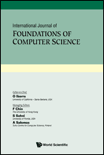
INTERNATIONAL JOURNAL OF FOUNDATIONS OF COMPUTER SCIENCE
Building the Future on Solid Computational FoundationsThe International Journal of Foundations of Computer Science, published by World Scientific Publishing Co Pte Ltd, is a premier repository for cutting-edge research in the field of computer science, emphasizing foundational theories and methodologies. With an ISSN of 0129-0541 and an E-ISSN of 1793-6373, this journal has established itself as a valuable resource since its inception in 2000, continuously contributing to scholarly discourse up to the present year, 2024. It is ranked in the Q2 quartile of computer science categories, indicating its notable impact and relevance within the academic community, particularly in miscellaneous subsections of the field. While it does not currently offer open access options, it remains a crucial platform for researchers, professionals, and students seeking to deepen their understanding of computational foundations, algorithms, and theoretical frameworks. The journal encourages submissions that push the boundaries of knowledge and invites innovative approaches that address contemporary challenges in computer science.
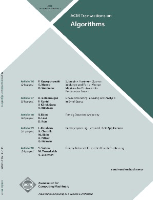
ACM Transactions on Algorithms
Innovating Solutions Through Algorithmic InsightsACM Transactions on Algorithms (ISSN: 1549-6325, E-ISSN: 1549-6333) is an esteemed academic journal published by the Association for Computing Machinery (ACM), dedicated to advancing the field of algorithms within the broad domain of mathematics. With an impressive 2023 Quartile Ranking of Q1 in Mathematics (miscellaneous) and a Scopus rank placing it in the 15th percentile of its category, this journal is a pivotal resource for researchers, professionals, and students alike. Covering topics from algorithm design and analysis to applications in diverse areas, it serves as a platform for publishing high-quality, peer-reviewed research that significantly contributes to theoretical advancements and practical implementations. Although it is not an open-access journal, its impact in the academic community is profound, ensuring that vital findings reach a wide audience while promoting innovation and excellence in algorithm research. Established in 2005, with contributions continuing through 2024, ACM Transactions on Algorithms remains at the forefront of its field, underpinning significant developments and collaborations in algorithmic research.

DISCRETE MATHEMATICS AND THEORETICAL COMPUTER SCIENCE
Shaping the Future of Computer Science through Discrete MathematicsDISCRETE MATHEMATICS AND THEORETICAL COMPUTER SCIENCE, published by DISCRETE MATHEMATICS THEORETICAL COMPUTER SCIENCE in France, stands as a significant open-access journal since 1997, publishing innovative research articles within the intersecting disciplines of discrete mathematics and theoretical computer science. With an ISSN of 1462-7264 and an E-ISSN of 1365-8050, this journal aims to provide a platform for scholarly discourse and dissemination of knowledge, making it accessible to a global audience. It is recognized for its contributions, achieving a Q2 ranking in both Computer Science (Miscellaneous) and Discrete Mathematics and Combinatorics, alongside a Q3 ranking in Theoretical Computer Science as of 2023. The journal’s rigorous selection process ensures that only high-quality research is published, promoting advancements in these critical areas of study. Researchers, professionals, and students alike can benefit from its comprehensive articles that not only enhance theoretical understanding but also foster practical applications in the ever-evolving landscape of computer science.